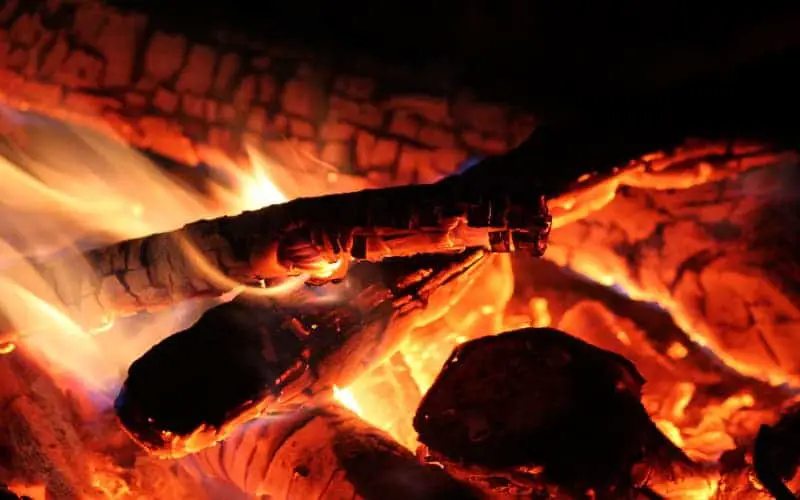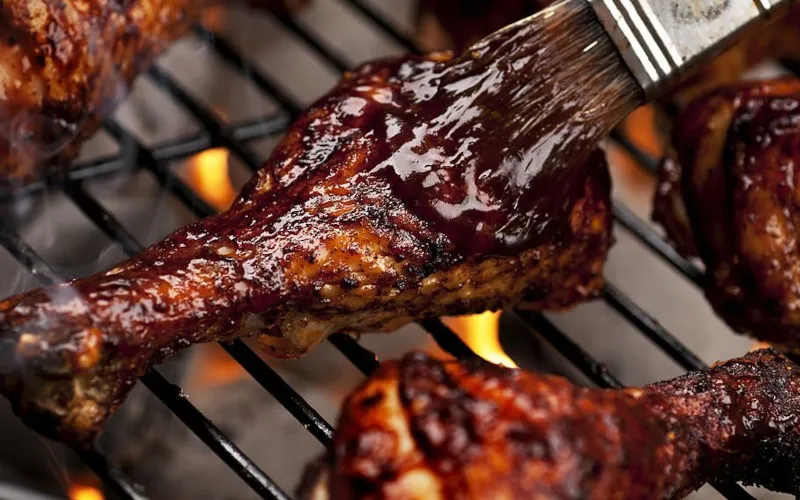What are the differences between prime rib and beef tenderloin? Both cuts of beef come from the loin section of the cow, and both can be prepared as roasts or steaks. However, it’s important to understand how these two cuts differ in terms of marbling, flavor, texture, and cost before you begin deciding which one to buy.
Here is an in-depth comparison of prime rib vs beef tenderloin that will help you decide which cut to buy next time you’re at the butcher shop or grocery store.
What is Prime Rib?
Prime rib refers to classic roast beef or entire rib roast, typically served holidays and special occasions. It is also known as standing rib roast, prime rib of beef, and roasting piece. The meat from the prime rib is moist, tender, and flavorful.
The marbling or intramuscular fat is an awesome source of moisture and flavor. Therefore, it is very important to select high-quality cuts of meat with little intramuscular fat. This will ensure that your prime rib recipe will be a success!
The age of the animal will also influence its tenderness. The meat from a younger animal is tenderer than from an older one. Cuts taken from a large rib roast are known as prime rib roasts, and cuts taken from a small rib roast are known as rib-eye steaks.
Not every prime rib can be prepared bone-in. For example, if you are planning to cook a standing roast, you will need to remove some of its bones. This is because it will not fit in your oven otherwise. In addition, most people prefer boneless roasts as they are easier to carve and serve.
When cooking a boneless roast, make sure that it has been butterflied or flattened so that it cooks evenly.
Related: How to Reheat Prime Rib
What is Beef Tenderloin?
The tenderloin, or filet mignon as it’s also known, is one of several cuts taken from a cow’s short loin. It is easily recognizable for its cylindrical shape, which is why it is often referred to as the baseball cut.
While similar in shape to another popular choice among steak lovers (the porterhouse), tenderloins are different because they do not contain bone. They can be cooked whole but are most commonly sliced into individual portions and sold.
Because of their high-fat content and low connective tissue, tenderloins are considered some of the more tender cuts available. They can be grilled on a barbeque or roasted in an oven with minimal preparation time required.
In addition to being delicious, tenderloins are also quite affordable compared to other types of steaks. This makes them ideal for those who want to splurge without breaking their budget.
Difference Between Prime Rib and Beef Tenderloin
To assist you to select the right cut of meat for your next dinner party, here are some facts about two popular cuts: prime rib and beef tenderloin.
Tenderness and fat content
The beef tenderloin, or filet mignon, is a lean cut of meat that is very tender. The prime rib, on the other hand, has more fat and marbling. This means it will be juicier and more flavorful than beef tenderloin. However, you may want to trim some of that fat off if you watch your calories.
Cut section
The beef tenderloin is a single muscle that comes from the loin section of a cow. It’s long and thin, making it perfect for grilling or broiling. The loin section is a part of a cow’s body where you can find other popular cuts like ribeye steak and strip steak.
A prime rib, on the other hand, comes from the rib section of a cow.
Flavor
The flavor of a prime rib will be more intense than that of beef tenderloin. This is because marbling produces fat, which releases flavorful oils when cooked. But if you’re looking for something leaner and less fatty, you might want to go with a beef tenderloin instead.
In addition, prime rib is juicier than a beef tenderloin, which makes it great for roasting or grilling.
Cost
The Beef tenderloin is more expensive than a prime rib. This is because it’s a more popular cut of meat, and it’s also very lean. If you want to save money on your next dinner party, you might want to go with a prime rib instead.
However, prime rib is also pricier because it’s often sold in smaller portions. A beef tenderloin usually comes in a larger size that can feed two or three people.
Shape
The Beef tenderloin is a cylindrical shape and boneless. A prime rib, on the other hand, has bones in it. This makes it easier to carve into slices for serving. However, if you’re planning to grill or roast your meat, you might want to go with a beef tenderloin instead.
It cooks faster than prime rib, which means you can get your meal ready sooner.
Type of cut
The beef tenderloin is a lean cut of meat that’s best suited for broiling or grilling. It has a subprimal cut number and, therefore, it doesn’t have as much fat marbling as other cuts like ribeye steak or strip steak. A prime rib, on the other hand, is very juicy and flavorful because it contains more fat than beef tenderloin.
It is among eight primal cuts of beef, which come from a cow’s rib section.
Steaks
Steaks are similar cuts of meat, except for one main difference: prime rib is usually larger than beef tenderloin. This makes it a great option for serving more people at your next dinner party. A prime rib can be cut into several small servings, but a beef tenderloin is often sold in one large piece to feed two or three people.
Cooking methods
The cooking method you choose will depend on what you want to get out of your meal. For example, if you want something juicy and flavorful, then roasting or grilling is best. But if you’re looking for something leaner and less fatty, broiling or grilling would also work well with beef tenderloin.
On the other hand, a prime rib can be roasted or grilled, but it can also be cooked in liquid like soup or stew.
Prime Rib vs Beef Tenderloin: Which is Better?
Prime rib and beef tenderloin are high-end cuts of beef with their own culinary uses. It’s difficult to determine which cut is better, but there are a few aspects you should consider when making your decision.
Price
If you think the price is the determinant of which cut of beef is better, then prime rib wins by a landslide. Prime rib is cheaper than tenderloin because it comes from an area on a cow that’s used more often for other cuts like sirloin and short ribs.
This means there’s less demand for prime rib compared to tenderloin, so it’s less expensive. You can expect to pay about $18 per pound for prime rib and $28 to $45 per pound for tenderloin.
Fat content and tenderness
Two factors determine tenderness: connective tissue and fat content. Because prime rib is a fattier cut of beef, it tends to be tougher and less tender than tenderloin. This doesn’t mean prime rib isn’t a good choice for cooking, but you need to cook it properly to make sure it isn’t tough or chewy.
Tenderloin has more collagen (i.e., connective tissue) than prime rib, so it requires longer cooking times at lower temperatures to break down its toughness. But because tenderloin is leaner, it has more flavor and juiciness when cooked correctly.
Flavor profile
While both cuts have their own distinct flavor profiles, the prime rib has a sweeter taste due to the marbling production of fat. Marbling is when fat is distributed throughout muscles. Prime rib tends to be juicier than tenderloin because it’s fattier.
If you’re going for flavor and juiciness over tenderness, then prime rib is your best bet. However, tenderloin can still be quite flavorful even though it doesn’t have as much fat as prime rib. It all depends on how you cook it.
Frequently Asked Questions
What Does Prime Rib Taste Like?
There is no way you can mistake the taste of prime rib. The meat is tender and juicy, with a rich, beefy flavor that’s unmistakable. It’s also fairly easy to cook, as long as you follow a few basic guidelines:
The most important step in cooking prime rib is to make sure it’s at room temperature before putting it in your oven or on your grill. That gives it time to absorb its own juices, which will keep it from drying out while cooking.
Don’t season it too early, as salt can draw out moisture from your meat. Instead, wait until about 30 minutes before you’re ready to cook your prime rib. Finally, don’t skip out on letting it rest after cooking.
Where To Buy Prime Rib?
Wondering where you can buy prime rib? If you’re lucky enough to live near a butcher, they’ll likely have some in stock. Otherwise, your best bet is to check out your local supermarket. Prime rib is often sold as part of a holiday meal deal (think Thanksgiving or Christmas), but if not, just ask your butcher if they carry it.
They should be able to tell you what days and times it comes in and how much it costs per pound.
Which End Of Prime Rib Is Better?
The small end of the prime rib is often considered better quality than its larger counterpart. This is because it has a higher fat content, which makes it juicier and more flavorful. However, if you’re just cooking for yourself or a few people, you might want to go with something a little more manageable in size—like a boneless ribeye steak instead.
How Much Beef Tenderloin For 6 Adults?
1 1/2 to 2 pounds of beef tenderloin is enough for 6 adults. You can always cook more if you’re feeding a crowd, but if you’re cooking for just a few people, it’s best to err on the side of caution and make sure you have enough food. If you’re planning on serving prime rib at your holiday meal, that might be all you need.
How Much Beef Tenderloin For 8 Adults?
If you have at least 1/2 pound per adult, 8 adults require 4 pounds. It’s better to have too much than not enough! Also, if you’re planning on serving prime rib at your holiday meal, make sure you have enough!
How Much Beef Tenderloin For 10 Adults?
Assuming every adult consumes 1/2 pounds of beef tenderloin, 10 adults will require 5 pounds. If that’s not enough, make sure you have plenty of other food for your guests! You can always add a little more beef tenderloin to your meal later if it runs out too quickly.
How Much Beef Tenderloin For 12 Adults?
With an estimation of 1/2 pound or 8 ounces per adult, 12 adults will require 6 pounds. If you want to make sure there’s enough for everyone, then go with 7 pounds instead. You can always cook more if you run out!
How Much Beef Tenderloin For 15 Adults?
For 15 adults, you’ll need 10 pounds of beef tenderloin. That might sound like a lot, but it’s likely to be enough for most people. If there are leftovers, either repurpose them into another meal or store them in your freezer until needed.
Conclusion
Both prime rib and beef tenderloin are excellent choices for a romantic dinner. Prime rib is typically more affordable than beef tenderloin, making it a good choice for a special occasion.
However, if you’re looking to splurge on your partner, you can’t go wrong with beef tenderloin. Just give each type a try — you might be surprised by which one you prefer!





